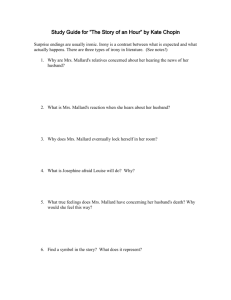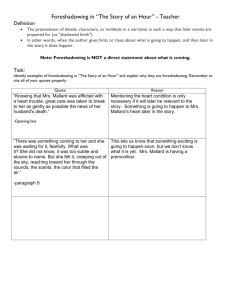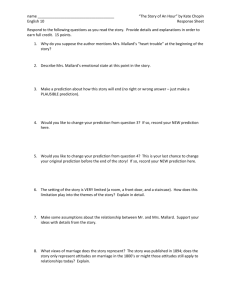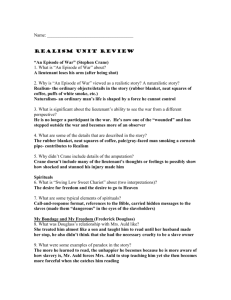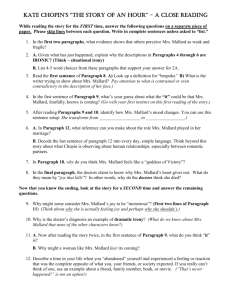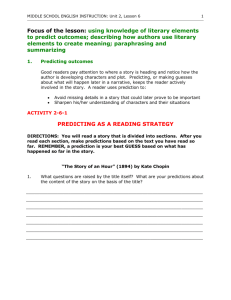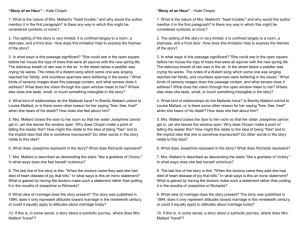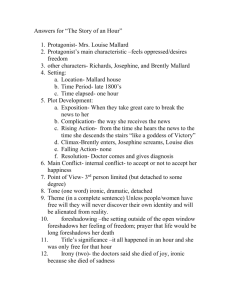english 30-1: short stories, poetry, and visuals unit - English 30
advertisement
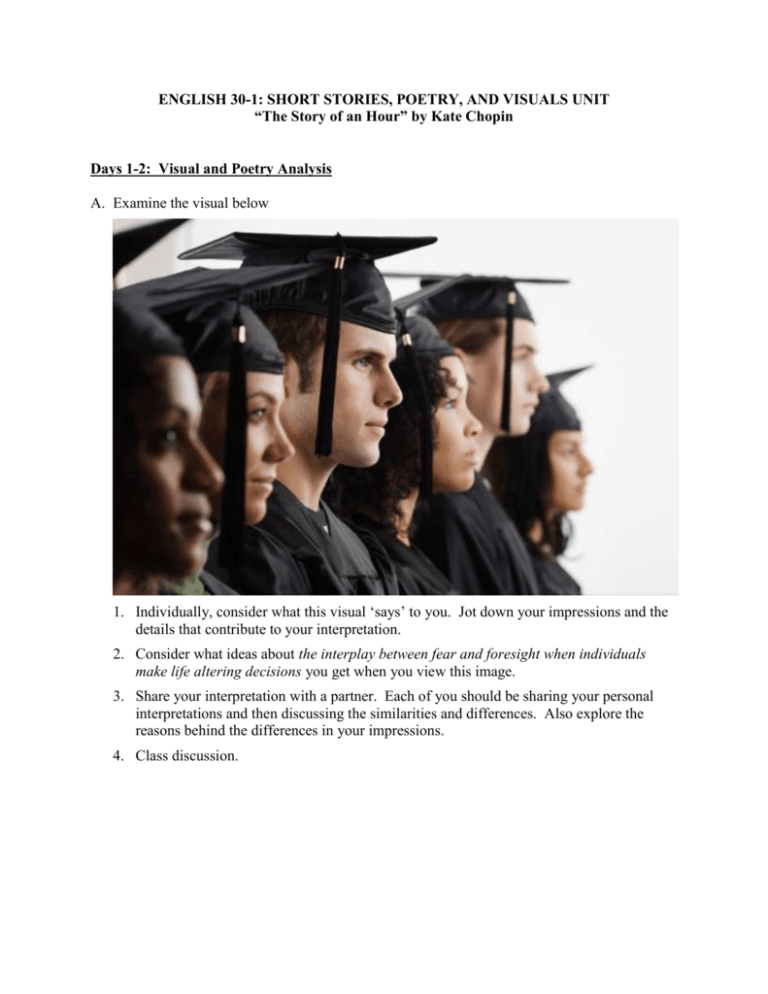
ENGLISH 30-1: SHORT STORIES, POETRY, AND VISUALS UNIT “The Story of an Hour” by Kate Chopin Days 1-2: Visual and Poetry Analysis A. Examine the visual below 1. Individually, consider what this visual ‘says’ to you. Jot down your impressions and the details that contribute to your interpretation. 2. Consider what ideas about the interplay between fear and foresight when individuals make life altering decisions you get when you view this image. 3. Share your interpretation with a partner. Each of you should be sharing your personal interpretations and then discussing the similarities and differences. Also explore the reasons behind the differences in your impressions. 4. Class discussion. B. Read and analyze the poem “The Diver” by Robert Currie The Diver The bridge like a Roman fort held the river and the beach held our vision steady through the waving heat held us all while the solitary figure struggled up the arch his knees braced against the rivets Below someone shook out his towel while others bet upon his chance At the summit of the span he rose his arms outstretched flung a cross against the sun and the whole world hung beneath him our eyes nailing him to the sky Suspension for an instant and forever A slow plunge toward the water and he came down from above dropping beneath the surface like a stone The river circling away grew silent as held breath still as death Then from unknown depths his head broke the water shook out a crown of sunlit spray brought release new life thrilling in our chests - Robert Currie Assignment: Using the Responding to Poetry handout, the class will examine the thirteen categories as they apply to the poem “The Diver” by Robert Currie. We will also discuss how the poem relates to the question: what ideas about the interplay between fear and foresight when individuals make life altering decisions are explored through the poem? Day 3: Analysis of “The Story of an Hour” by Kate Chopin Pre-Reading 1. Terminology: a. attenuated moment b. epiphany c. foreshadowing d. oxymoron e. dramatic irony f. situational irony g. contrast 2. Discussion: a. How do you view marriage? The role of women? Men? Historically? Today? b. What potential disadvantages of marriage might exist for either gender? During Reading 3. Motif Tracking: As we read the story, identify passages addressing fear, foresight, and lifealtering choices within the text Post Reading 4. Reading Comprehension Practice: multiple-choice questions 5. General Discussion: a. What does the story suggest about marriage? How? b. What does the ending mean? 6. Think-Pair-Share: motif tracking Factual Questions 1. What is the first and last name of the author? 2. What is the first and last name of the main character? 3. What is the first and last name of the husband? 4. Where on the list of those killed was the husband's name? 5. What type of sickness does the main character suffer from? 6. What two oxymorons are in the story? Interpretation Questions 7. How does the first sentence employ foreshadowing? 8. Explain what is significant about the patches of blue sky showing through the clouds in the west? 9. Examine the language used to describe the attenuated moment and the resultant epiphany. What effect is created? State four examples of the language used to create this effect. 10. What are the two meanings of heart condition in the story? 11. What is significant about the image near the end of the story as the main character comes downstairs? 12. What is the significance of the title? 13. How is the story dramatically ironic? situationally ironic? 14. How does the author use the naming of the protagonist to make her point? 15. There are three incidents of “shock” for Mrs. Mallard in this story. Identify each and analyze her reaction. 16. How do you feel about Mrs. Mallard at the end of the story? Why? 17. Pick out at least five phrases which you think are especially important to the story. Briefly describe why you chose each. 18. What questions about characters or motivations or plot does this story leave in your mind? Personal Response to Texts What do these texts (the graduation photo, the poem “The Diver”, and “The Story of an Hour”) suggest about the interplay between fear and foresight when individuals make life altering decisions? Support your idea(s) with reference to one or more of the texts presented and to your previous knowledge and/or experience. ENGLISH 30-1 “The Story of an Hour” by Kate Chopin 1. The purpose of the second telegram (lines 7-8) in terms of plot function is to A. foreshadow Mrs. Mallard' s refusal to accept the inevitable B. support the impact of the surprise ending C. reinforce the frailty of Mrs. Mallard D. instill suspense in the story 2. The vivid description in lines 17 to 21 serves MAINLY as A. a reflection of the story's setting B. a reaffirmation of Mrs. Mallard's courage during tragedy C. an indication of the significance of nature in Mrs. Mallard's life D. an ironic comment on life's resurgence in the presence of tragedy 3. The "patches of blue sky" in lines 22 and 29 foreshadow Mrs. Mallard's sense of A. loss B. shock C. stability D. liberation 4. The "repression" and "strength" suggested in Mrs. Mallard's face (lines 27-28) are confirmed by her A. responses to her husband's death B. sister's tact as she tells Mrs. Mallard of the death C. sister's concern for Mrs. Mallard's undisciplined grief D. appreciation for the protectiveness of her husband's friend 5. As Mrs. Mallard contemplates her past, she realizes that her husband's temperament was A. gentle but spiteful B. generous but cruel C. loving but overbearing D. protective but indifferent 6. Mrs. Mallard's responses to the idea that "life might be long" (lines 68-70) indicate her A. confused emotions B. sense of insecurity C. overwhelming guilt D. altered point of view 7. Mrs. Mallard's ultimate response to the news of her husband's death is one of A. regret B. despair C. courage D. exultation 8. The irony of the story is BEST expressed in A. "There was something coming to her and she was waiting for it"(line 31) B. "She knew that she would weep again" (line 46) C. "He had been far from the scene of accident" (line 77) D. ". . . she had died of heart disease -- of joy that kills" (lines 81-82)
